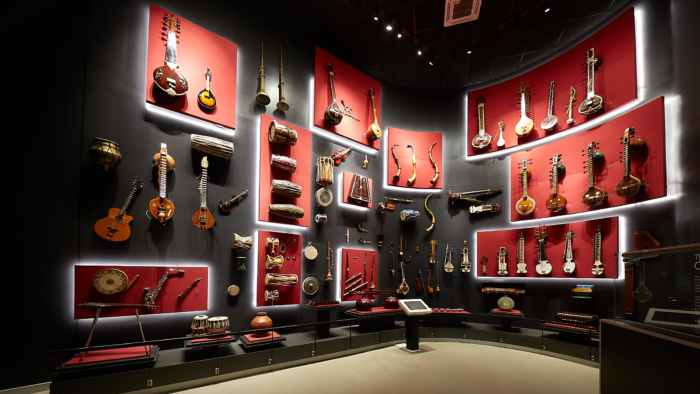The Indian Music Experience, situated in Bengaluru, is India's first interactive music experience, comprising hi-tech multimedia Exhibit Galleries, a Sound Garden, a Learning Centre for music education, and several performance spaces. Since opening in 2019, the IME has had over 45,000 visitors in-person and many thousands more online.
On this International Museum Day, CSP brings to you a conversation with Manasi Prasad, Director at the Indian Museum Experience. Manasi shares her insights on curating the IME and its various initiatives, and also discusses museums as an instrument of soft power.
What is the vision of the Indian Music Experience and how did it shape up?
The vision of the Indian Music Experience is to increase the understanding of Indian music among the youth and to build community through music.
The Indian Music Experience Museum was conceptualized as a space for everyone, but especially young people to experience the history and diversity of Indian music from the traditional to the contemporary. Our Founder, Jaishankar, during his visit to Seattle visited the Experience Music Project (now called the Museum of Pop Culture) and was struck by how a museum had been designed as a visitor-centric space that celebrates creativity. I had also had a burning thought- if there is an IIM (Indian Institute of Management) why can there not be another IIM - Indian Institute of Music, which celebrates, preserves and propagates our music? It was through this combination of visions and also a need for public spaces for engagement with art that the IME was born.
Who are your primary visitors and what are some of the steps taken to engage them beyond the museum experience?
Our primary visitors are youth - these are millennials who are working professionals, those with young families, or even college students. While these groups naturally come to the museum, we also do specific outreach and partnerships with schools to bring in schools for field trips. Events, especially classical music concerts do attract a slightly older demographic including senior citizens. While most of our visitors are from Bangalore (this is also due to the pandemic-related decline in travel), we are seeing a gradual increase in those visiting from other parts of the country and the world.
As we were seeing mainly middle- and upper-class visitors at the museum, and driven by the belief that the art experience should be inclusive, we launched a community initiative - Project Svaritha- in 2021, through which we bring children from poor and socially disadvantaged backgrounds, and those with neurodivergent needs (autistic) to the museum for immersive experiences and workshops.
During pandemic-related closures, we did a host of online events, and continue those, in addition to in-person events. In general, we find talks, panel discussions and some workshops work well online, while performances and interactive sessions are best experienced in person. Now we typically do 2 online and 2 in-person events a month.

Coming from a culture where classical music continues to be performed, practiced and preserved, thus becoming a living tradition, why is there a need for a museum dedicated to music?
While classical music is indeed a living tradition, access and understanding of it continue to be limited. If we want our music traditions to continue to thrive, we need generations of young people to understand, appreciate, learn and support them. This can happen only through an engagement with music that is both educational and enriching, but also fun and interactive.
Secondly, while the tradition continues to live, what means do we have to preserve our history? Recordings of old masters, artifacts related to musicians and technology, musical instruments and their making- all these need to be preserved, interpreted and documented as they form a vital link to the past and the basis for future development. Finally, while music is indeed all around us, I believe the role of museums is in providing information, interpretation and inspiration; you may find music on YouTube but do you know what are its constituent elements, why it is important, or the story behind who made it? This is what a museum, especially an interactive and experiential museum can provide.
What are some of the essential attributes and practices followed while curating a music-gallery or exhibition?
The most important principle of designing museums and exhibits is to put the visitor at the heart of the experience. It is not just about what you need to tell the visitor, but what and how the visitor wants to learn. This can only come from a deep understanding of who the visitor is, and what are their needs, enablers and barriers. Hence, curation must start with focus groups, surveys and other means of gathering information on the visitor.
With a gallery on music, the challenge is to convert what is primarily an aural experience into a multisensory one, involving seeing, hearing and touch.
Finally, it is important to layer the content – there will be those who want to skim and get a sense, while others would want to go deeper to understand more. The curation should offer layers through interactives, listening kiosks etc to make it richer. It is also important to know what not to include and where to stop, without overwhelming the visitor with information!
IME has many unique experiences. The Sound Garden has 10 music installations that can be played by anyone and provide an introduction to the principles of physics such as vibration, frequency, amplification and resonance. The computer interactives such as Hybrid Sounds allow the visitor to get a hands-on experience of what a music producer does. The instruments gallery, which is the most photographed part of the museum has a display of over 100 instruments accompanied by an audiovisual kiosk that gives detailed information about each instrument, its origin, parts and playing.

What makes museums as an instrument of soft power? What does IME aim to communicate to a global audience and how?
Museums bring together a whole range of a country’s cultural aspects - history, diversity, language, cultural practices and philosophies. Like Paulo Coelho says - culture makes us understand each other better.
In an era of stereotypes, where we reduce people to certain archetypes that we see through social or mainstream media, museums provide spaces for a more nuanced understanding of identity and context. People also need to feel proud of their country and heritage, and visiting museums can reinforce this pride and a sense of rootedness, which are essential in today’s globalized context.
Internationally, Indian music is most associated with Bollywood, or in some places classical (mainly Hindustani) music. However, this does not capture the huge diversity of music traditions that exist - the folk and tribal forms, regional devotional music, or even the new contemporary music that’s coming out of India that combines Indian and global sounds (hip hop, indie rock, Punjabi, fusion etc.).
This is what IME aims to communicate to the world through our exhibits, events, education and partnerships. For instance, IME is part of the GRAMMY Museum Affiliate Network, comprising music museums and universities around the world such as The Beatles Story in Liverpool, Berklee College of Music or the Bob Marley Museum in Jamaica. This allows for sharing of best practices, educational material etc; it also facilitates collaboration between institutions through traveling exhibitions and joint programs. This network allows us to expand our sphere of influence globally, and also to gain ideas and inspiration from programs and projects in other parts of the world. As an example, our program with Autism is inspired by the work that the GRAMMY Museum does through their Sensory Saturdays.

How could India encourage music-focused experiential tourism? Do you see potential in this space and why?
There is a lot of global interest in Indian music. We routinely host international musicians for concerts and are also part of a music-focused residency program with the Goethe Institut for musicians from Germany. We facilitate several international musicians to learn from and collaborate with their Indian counterparts.
Beyond musicians themselves, are those who come to India for a cultural experience of art, Yoga, meditation etc. where I feel there isn't a ‘circuit’ or planned tour of spaces and destinations for cultural tourism. Such an immersive experience, involving several destinations and institutions, can magnify what each institution can offer individually. I believe that this is a space with a lot of potential - despite the information being available at your fingertips in any part of the world, it is only through immersive experiences that true learning happens. I have done several concerts, workshops and talks for students from international universities in Spain, the United States etc. - all of them want to come to India…money is not the problem, rather they don’t know where and how to start! As India’s relevance and stature in the world grows, so is the desire to understand more about our country and its people, and we must do everything we can to capitalize on this interest.





